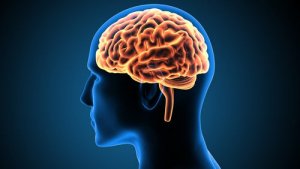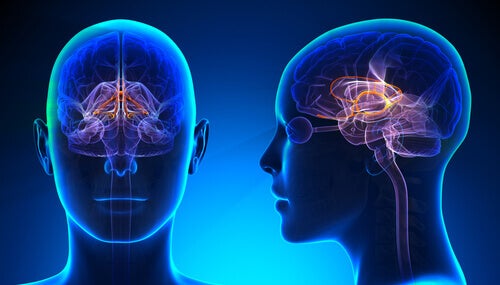The Cingulate Gyrus

The cingulate gyrus is a part of the human brain that exists in both hemispheres. This structure, along with the parahippocampal gyrus, forms the limbic cortex of the brain’s limbic system.
When you’re unsettled or anxious, your cingulate gyrus is active. It helps you express your emotional state through gestures, posture, and movement.
As you can imagine, the cingulate gyrus has become very important for neurocognitive and cognitive studies. In addition, scientists are discovering that this part of the human brain is involved in a variety of brain functions as well as in some disorders.
Alzheimer’s disease and depression are two important examples of disorders that involve the cingulate gyrus. However, it’s also involved in disorders such as schizophrenia, bipolar disorder, some anxiety disorders, and addiction.

Structure and function of the cingulate gyrus
Anterior cingulate cortex
In general terms, this part of the cerebral cortex plays a special role in autonomic and endocrine responses to emotions and memory storage.
Neuroscientists also believe that it helps regulate endocrine function and the expression of autonomous states. It does that through its projections with the solitary nucleus and the dorsal nucleus of the vagus nerve.
These aren’t the only areas where the anterior cingulate cortex carries out projections. It also has extensive connections with:
- The amygdala. This region of the brain is highly involved in emotional response.
- The periaqueductal gray. This zone plays an important role in modulating certain pain circuits.
- Medial dorsal nucleus and the anterior thalamic nucleus. Scientists believe that functions such as learning, memory, and attention might involve these nuclei.
Medial cingulate cortex
This part of the cingulate gyrus activates when you make predictions about the results of behavior. It also helps you execute this behavior through projections on the prefrontal dorsolateral cortex, the supplementary motor areas, the parietal cortex, and the spinal cord.
That’s why scientists believe that the medial cingulate cortex is related to information processing during decision-making. Concretely, it relates to decisions based on rewards and cognitive activity associated with intentional motor control.

Posterior cingulate cortex
The cingulate gyrus relates to a topokinetic memory circuit. In concrete terms, its primary function takes place in visual-spatial orientation.
The front part appears to be crucial in the pre-determined mode network of the brain. In other words, a system in the brain that stays active even when you aren’t paying attention to external stimuli.
Neuroscientists also believe that it plays a role in internally-directed cognition processes. Some of these are memory recovery, planning, and spatial information processing.
They also theorize that this part of the brain is related to self-control. It may also play a role in the evaluation of events that have to do with self-relevance.
The dorsal part of the posterior cingulate cortex is closely linked to the pre-motor, visual dorsal, and orbitofrontal regions of the brain. It also participates in bodily orientation and visual space.
The retrosplenial cortex
This part of the cingulate gyrus seems to come into play in autobiographic memory and imagination. As a result, this part of the cingulate gyrus may have something to do with neurological disorders that cause memory loss.
It seems that the cingulate gyrus mediates human emotional response. It’s also responsible for assigning value to emotions in response to external and internal stimuli. The cingulate gyrus is especially important for being able to express your emotions out loud.
In conclusion, damage to the cingulate gyrus can affect your ability to respond to certain stimuli. That could lead to aggressive behavior, shyness, or a decrease in emotional expression.
The cingulate gyrus is a part of the human brain that exists in both hemispheres. This structure, along with the parahippocampal gyrus, forms the limbic cortex of the brain’s limbic system.
When you’re unsettled or anxious, your cingulate gyrus is active. It helps you express your emotional state through gestures, posture, and movement.
As you can imagine, the cingulate gyrus has become very important for neurocognitive and cognitive studies. In addition, scientists are discovering that this part of the human brain is involved in a variety of brain functions as well as in some disorders.
Alzheimer’s disease and depression are two important examples of disorders that involve the cingulate gyrus. However, it’s also involved in disorders such as schizophrenia, bipolar disorder, some anxiety disorders, and addiction.

Structure and function of the cingulate gyrus
Anterior cingulate cortex
In general terms, this part of the cerebral cortex plays a special role in autonomic and endocrine responses to emotions and memory storage.
Neuroscientists also believe that it helps regulate endocrine function and the expression of autonomous states. It does that through its projections with the solitary nucleus and the dorsal nucleus of the vagus nerve.
These aren’t the only areas where the anterior cingulate cortex carries out projections. It also has extensive connections with:
- The amygdala. This region of the brain is highly involved in emotional response.
- The periaqueductal gray. This zone plays an important role in modulating certain pain circuits.
- Medial dorsal nucleus and the anterior thalamic nucleus. Scientists believe that functions such as learning, memory, and attention might involve these nuclei.
Medial cingulate cortex
This part of the cingulate gyrus activates when you make predictions about the results of behavior. It also helps you execute this behavior through projections on the prefrontal dorsolateral cortex, the supplementary motor areas, the parietal cortex, and the spinal cord.
That’s why scientists believe that the medial cingulate cortex is related to information processing during decision-making. Concretely, it relates to decisions based on rewards and cognitive activity associated with intentional motor control.

Posterior cingulate cortex
The cingulate gyrus relates to a topokinetic memory circuit. In concrete terms, its primary function takes place in visual-spatial orientation.
The front part appears to be crucial in the pre-determined mode network of the brain. In other words, a system in the brain that stays active even when you aren’t paying attention to external stimuli.
Neuroscientists also believe that it plays a role in internally-directed cognition processes. Some of these are memory recovery, planning, and spatial information processing.
They also theorize that this part of the brain is related to self-control. It may also play a role in the evaluation of events that have to do with self-relevance.
The dorsal part of the posterior cingulate cortex is closely linked to the pre-motor, visual dorsal, and orbitofrontal regions of the brain. It also participates in bodily orientation and visual space.
The retrosplenial cortex
This part of the cingulate gyrus seems to come into play in autobiographic memory and imagination. As a result, this part of the cingulate gyrus may have something to do with neurological disorders that cause memory loss.
It seems that the cingulate gyrus mediates human emotional response. It’s also responsible for assigning value to emotions in response to external and internal stimuli. The cingulate gyrus is especially important for being able to express your emotions out loud.
In conclusion, damage to the cingulate gyrus can affect your ability to respond to certain stimuli. That could lead to aggressive behavior, shyness, or a decrease in emotional expression.
All cited sources were thoroughly reviewed by our team to ensure their quality, reliability, currency, and validity. The bibliography of this article was considered reliable and of academic or scientific accuracy.
-
Torta, D. M., & Cauda, F. (2011). Different functions in the cingulate cortex, a meta-analytic connectivity modeling study. Neuroimage, 56(4), 2157-2172.
-
Vogt, B. A. (2005). Pain and emotion interactions in subregions of the cingulate gyrus. Nature Reviews Neuroscience, 6(7), 533.
-
Paus, T., Petrides, M., Evans, A. C., & Meyer, E. (1993). Role of the human anterior cingulate cortex in the control of oculomotor, manual, and speech responses: a positron emission tomography study. Journal of neurophysiology, 70(2), 453-469.
-
Vogt, B. A. (2016). Midcingulate cortex: structure, connections, homologies, functions and diseases. Journal of chemical neuroanatomy, 74, 28-46.
-
Hoffstaedter, F., Grefkes, C., Caspers, S., Roski, C., Palomero‐Gallagher, N., Laird, A. R., … & Eickhoff, S. B. (2014). The role of anterior midcingulate cortex in cognitive motor control: evidence from functional connectivity analyses. Human brain mapping, 35(6), 2741-2753.
-
Vann, S. D., Aggleton, J. P., & Maguire, E. A. (2009). What does the retrosplenial cortex do?. Nature Reviews Neuroscience, 10(11), 792.
This text is provided for informational purposes only and does not replace consultation with a professional. If in doubt, consult your specialist.







